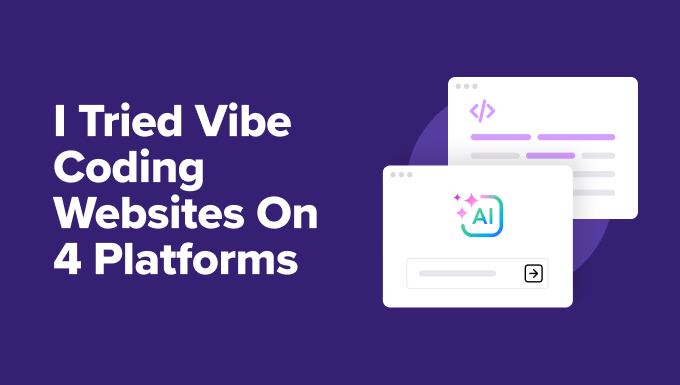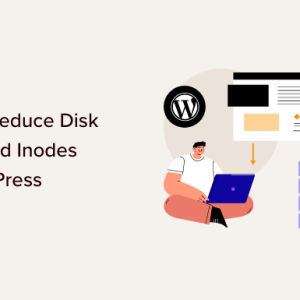I kept seeing people talk about “vibe coding websites”. Vibe coding is a fast, messy, and fun way to quickly make websites based on feeling instead of specs.
So, I tried it across four platforms to see what actually works in real life.
I built the same simple project four times and tracked speed, friction, and final polish. I also noted where vibe coding hits a wall, like when you need user accounts, payments, or a blog that doesn’t fall apart.
In this article, I will share my results with Lovable, Replit, SeedProd, and Hostinger Horizons for WordPress — what I loved, what broke, and who each platform is actually for.

Quick Comparison – The Best Platforms for Vibe Coding Websites
Here’s a quick overview of the platforms that I used for vibe coding:
| Platform | Best For / Use Case | Drag & Drop? | Integrations | Pricing |
|---|---|---|---|---|
| Lovable | Rapid prototypes and personal sites — describe it, ship it in minutes. | No | Basic embeds & forms | $25/month (Pro) |
| SeedProd | Polished professional websites— ideal for conversions with full WordPress control. | Yes | Full WordPress plugin ecosystem | $99.50/year (Plus plan) |
| Hostinger Horizons | AI website builder for quick & easy websites | Basic | Fewer integrations | $6.99/month |
| Replit | Hackable web apps — perfect for small tools, dashboards, and experiments. | No | APIs, webhooks, packages | $20/month (Core, billed annually) |
TL:DR Summary:
- SeedProd is my top pick for a professional website in minutes with eCommerce, forms, and bookings. It’s beginner-friendly, and its drag-and-drop builder makes customization effortless.
- If you’re comfortable exporting and importing sites, then Lovable is great for quick vibe-coded projects. Use Replit if you want to build AI-driven web apps and go deeper into vibe coding.
Here is a quick summary of topics I’ll cover in this guide:
- What Does “Vibe Coding” Websites Mean?
- How I Tested These Platforms
- Lovable — Fastest Way to Vibe Code a Website
- SeedProd — Best AI Vibe Coding Tool for WordPress
- Hostinger Horizons — AI Website Builder for Easy Launches
- Replit — Best for AI-Assisted Web App Development
- Final Recommendation: Which Is the Best Vibe Coding Platform to Build Websites?
- FAQs About Vibe Coding Websites
- Additional Resources for Creating Websites
What Does “Vibe Coding” Websites Mean?
Vibe coding is a simple way to build websites using AI tools. Here’s what it means:
- You describe what you want, and the tool generates a website for you.
- It’s fast and easy, with very little planning required.
- Great for testing ideas or creating simple personal sites quickly.
There are some trade-offs to vibe coding, but they can be easily addressed later on:
- Less control over structure and design compared to traditional website builders. However, it can be managed later on by customizing your site once it’s ready.
- Advanced features like eCommerce, memberships, and SEO are harder to manage. This can be addressed by choosing a vibe coding platform that already supports dynamic websites with WordPress.
That’s why in this article, I’ve tested four platforms to help you understand when vibe coding makes sense for standalone websites.
Who Should Try Vibe Coding Websites?
- Small businesses that need a quick website.
- Designers exploring different design approaches
- Students who are shipping projects and learning by doing.
You can use WordPress with some vibe coding platforms, which gives you the flexibility to grow your website using an existing ecosystem of plugins and integrations.
How I Tested These Platforms
I chose to build a fictional small business website for these tests. I imagined a local plumbing service provider that needed a simple website to attract customers, showcase services, and collect leads.
To make the test realistic, I also added a basic blog section to the site. This is something many small businesses want because writing helpful articles can improve SEO and bring in more traffic.
The goal wasn’t just to create a nice-looking website. I wanted to see if these platforms could build a functional site that’s ready to go live and grow with your business.
Here’s what I focused on while testing:
- Ease of building a full website: How simple was it to create a complete site from scratch? I tracked how long it took and whether the result was ready to go live without extra coding.
- Going live: How easy was it to publish the website to a real domain? Did the platform make hosting and deployment beginner-friendly?
- Customization options: After the site was live, how much freedom did I have to tweak the design, edit layouts, and add custom sections?
- Key integrations: Could I add booking systems, contact forms, payment gateways, and eCommerce features? How well did the platform handle SEO settings like titles, meta descriptions, and sitemaps?
- Pricing and support: How transparent was the pricing, and did the free plans offer enough for testing? I also checked whether the platform had helpful documentation, tutorials, or responsive customer support.
This approach gave me a complete picture of how each platform performs in real-world scenarios.
1. Lovable — The Fastest Way to Vibe Code a Website
Lovable was the fastest platform I tested. I typed in a simple prompt like “clean plumbing website with services, contact form, and blog,” and within minutes, it generated a complete site.
It even added placeholder images and sample content that matched the vibe perfectly. However, there was a tiny issue with a call-to-action button where the text was invisible.
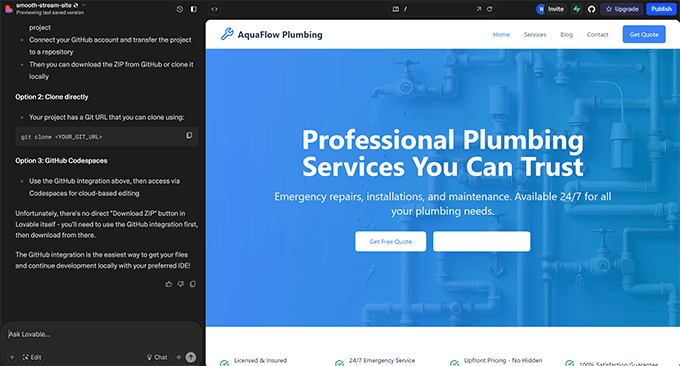
Plus, there’s no drag-and-drop builder. You can make conversational edits and tweak the text, but if you want full control over layout or reusable sections, you’ll quickly hit limitations.
Lovable does provide a publish option where you can connect your own domain name and host the website on Lovable servers. However, you will need to upgrade to the Pro plan for that.
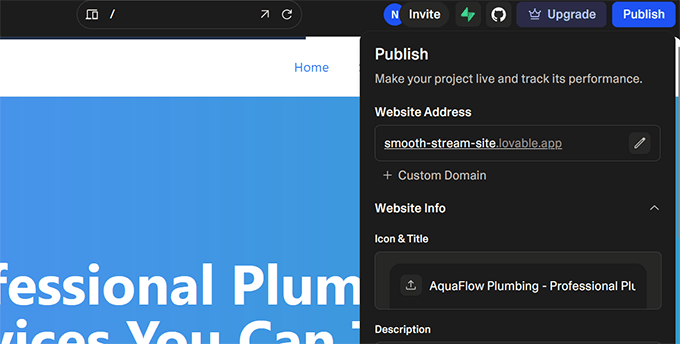
If you decide to host it yourself, you’ll first need to clone it to a GitHub repository and then download it. Alternatively, you can download it using Git to your computer, but this is not a very beginner-friendly option.
Lovable also integrated Supabase into the website, which is a database hosting service with a limited free plan. Considering the domain and subscription costs, this would make your small business website quite expensive.
| ✅ Pros of Lovable | ❌ Cons of Lovable |
|---|---|
| Extremely fast — went from idea to a working website in under 5 minutes | No true drag-and-drop customization after generation |
| Great for quick creative experiments and prototypes | Limited support for advanced features like bookings, eCommerce, or memberships |
| Very beginner-friendly — you describe what you want, and it builds it | Exporting the site is possible, but it’s not the smoothest process |
Best for: Quick prototypes, personal portfolios, link-in-bio pages, and simple microsites.
Not for: Small business websites that need eCommerce, booking forms, advanced SEO, or integrations with WordPress plugins.
Pricing: Free plan available. Paid plans start at $25/month.
Support: Basic documentation is available, but there is no live chat or guided onboarding.
2. SeedProd — The Best AI Vibe Coding Tool for WordPress
Unlike other vibe coding platforms, SeedProd AI gives you the speed of AI combined with the flexibility of WordPress.
I have extensively used SeedProd to build landing pages and entire websites. In my experience, it is the easiest WordPress page builder plugin, perfect for small business owners, bloggers, and anyone serious about growing online. See our full SeedProd review to learn more.
For this test, I wanted to see if I could generate a complete functional website using SeedProd’s AI website builder. I wanted a clean homepage, a services section, a contact form, and a basic blog.

First, I entered a concise description of the company and the website I wanted to build. You can add more details here to match your own requirements.
Then I clicked the “Create My Website Now” button, and SeedProd AI started working in the background.
Once finished, it showed me a button to preview my website and download it. The whole process took just 33 seconds.
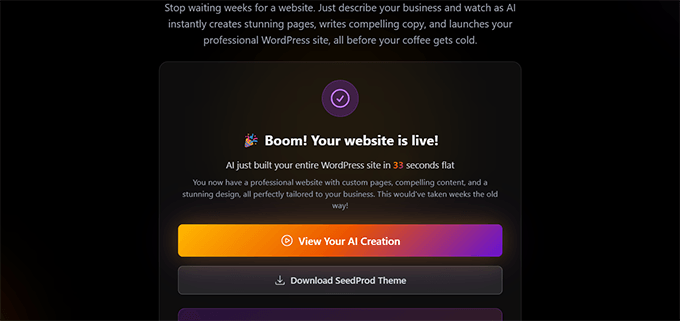
I checked the preview and was amazed at the attention to detail.
The website was highly optimized for a small business. There were prominent call to actions, business hours, company address, and contact information.

After the design was finalized, I downloaded it to my computer and connected it to hosting.
Pro Tip 💡: If you’re starting from scratch, I recommend using Bluehost to create a WordPress site. They are offering a massive discount and a free domain name to WPBeginner readers.
Once you have set up your WordPress website, you will need to install and activate the SeedProd plugin.
Note: SeedProd website builder is a paid WordPress plugin. You will need their Plus plan to unlock the theme builder. Click here to download SeedProd.
Next, simply go to the SeedProd » Import / Export page in your WordPress admin area.
Click on the ‘Choose File’ button to import your vibe-coded website.

Once imported, you need to go to the SeedProd » Theme Builder page and click on the edit link for any template you want to edit.
This will launch the SeedProd drag-and-drop editor. From here, you can point and click on any item to edit it.
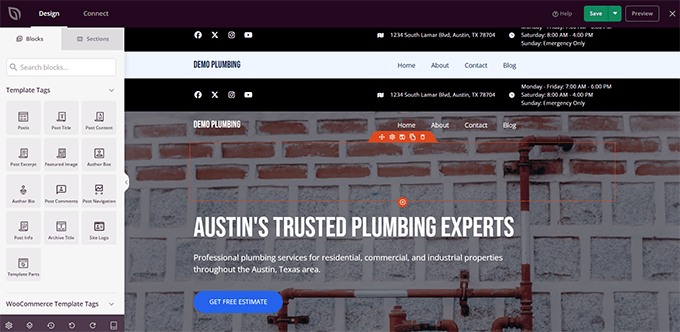
I really loved the deep AI integration in SeedProd blocks, which allows you to use AI to generate images, text, and copy for your website without leaving the drag-and-drop interface.
During my test, I also checked how well SeedProd handled advanced needs like booking forms, SEO, and eCommerce.
Because it’s built on WordPress, you can install plugins like WPForms for bookings, WooCommerce for selling products, and AIOSEO for optimization. That’s something standalone vibe coding tools can’t match.
| ✅ Pros of SeedProd | ❌ Cons of SeedProd |
|---|---|
| AI builds a full WordPress website in under a minute | Requires WordPress hosting to go live |
| Beginner-friendly drag-and-drop builder for easy customization | Not as instant as hosted vibe coding tools like Lovable |
| Integrates seamlessly with plugins for bookings, forms, payments, and SEO | The free plan is limited, so you’ll need a paid plan |
| You fully own your website and can export or move it anytime |
Best for: Small businesses, service providers, and bloggers who want a professional site that’s easy to customize and grow over time.
Not for: One-off prototypes or temporary landing pages where full ownership isn’t needed.
Pricing: Free version available. Paid plan starts at $99.50/year.
Support: Excellent documentation, video tutorials, and responsive support are included in paid plans.
3. Hostinger Horizons — AI Website Builder for Easy Launches
Hostinger Horizons is Hostinger’s new AI website builder. It works like other vibe coding tools: you write a prompt, it generates a professional-looking site, and hosting is handled for you.
I rebuilt my fictional plumbing site here to see how far the AI could take me.
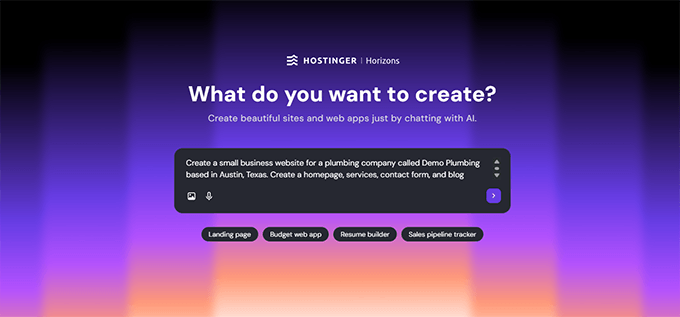
The first draft came together quickly from a single prompt.
The design looked clean, but I did hit a basic UI issue similar to Lovable: the main call-to-action button shipped with the same text and background color, so the label was invisible until I fixed it.
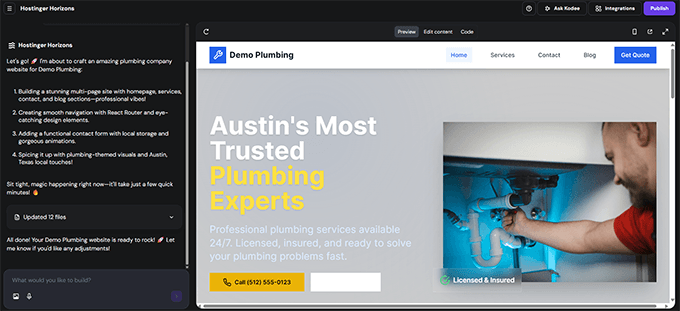
One standout feature of Horizons was the ability to edit text and images without writing a prompt.
I wouldn’t consider a full drag-and-drop builder, but more like a point-and-click editor for basic elements.
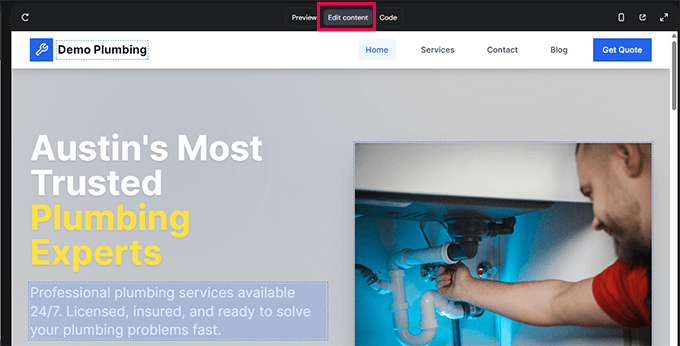
For layout or structural changes, you need to write additional prompts. Each Horizons plan is limited to a certain number of messages per month, so you’ll need to be careful not to hit your plan limits.
At the time of testing, Horizons listed integrations for Google AdSense, Supabase, Stripe, Zapier, and Mailchimp. Stripe lets you sell items, but this isn’t a full online store like WooCommerce or Shopify.
I also noticed that key pages like Contact and Blog were placeholders with no database or storage connected by default.
I also had to keep prompting to integrate the database. Even then, the blog system it built required me to manually edit code files each time I wanted to add a blog post.
On the other hand, I liked that Hostinger makes hosting your website easy. Hosting, SSL, and a domain are all in one place, and if you choose an annual plan, Hostinger includes a free domain as well.
| ✅ Pros of Horizons | ❌ Cons of Horizons |
|---|---|
| Fast AI draft and hosted publishing in one place | Required more prompting than other vibe coding platforms |
| Easy domain connection, and annual plans include a free domain | Limited plugin ecosystem; Stripe sales but no full eCommerce suite |
| Simple editor for text and image changes | |
| Core integrations: AdSense, Supabase, Stripe, Zapier, Mailchimp |
Best for: Beginners who want a very basic website with hosting.
Not for: Users who need full eCommerce, detailed SEO tools, or WordPress-level flexibility.
Pricing: Plans start around $6.99/month, with a free domain on annual billing.
Support: 24/7 AI assistant and live chat support, they also have very helpful knowledge base.
4. Replit — Best for AI-Assisted Web App Development
Replit isn’t a traditional website builder. Instead, it’s a powerful AI vibe coding platform designed for developers and users who want more control.
You describe what you want to build, and Replit’s AI can generate code, suggest improvements, and even debug errors. However, you’re still working directly with code, not a drag-and-drop editor.
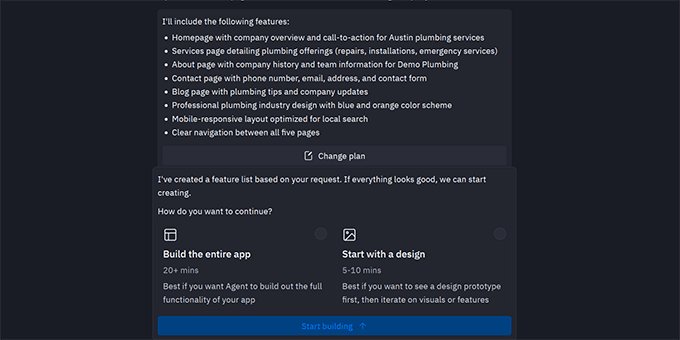
I prompted Replit to build the same small business website for a plumbing company. The AI handled it like any other coding project: it created a plan and showed it to me.
After that, it gave me two options: build the entire app or start with a design. I thought since we were comparing the AIs, we should give it full freedom to build it entirely.
It took a lot of time to complete (25+ minutes), but I was happy with the overall performance and the features. For instance, it automatically decided to add a testimonials section to the website.
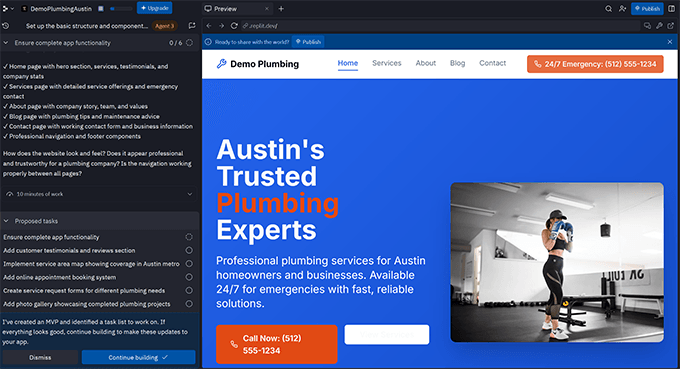
But unlike SeedProd or Hostinger AI, the site wasn’t instantly ready to go live.
I had the option to publish it on Replit by upgrading my plan and paying for hosting. This option was incredibly easy but expensive.
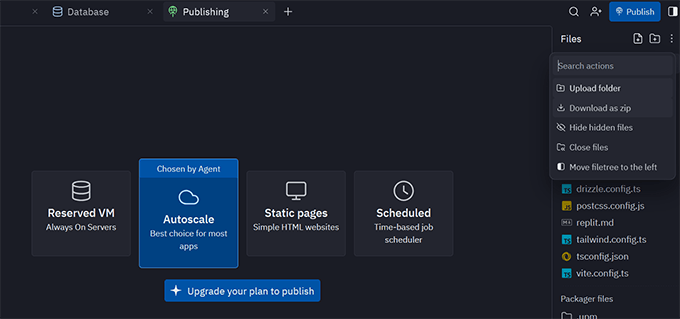
Alternatively, I could download the project as a zip file and set it up on any other hosting account myself. This was a cheaper option but required manual setup.
I was very happy with the website it created. But the tech stack it used was overly complicated, and hosting options were either expensive or required manual setup.
| ✅ Pros of Replit | ❌ Cons of Replit |
|---|---|
| Incredibly powerful AI that debugged, fixed, and delivered a ready-to-deploy website | Used an overly complicated tech stack for simpler tasks |
| Supports dynamic apps with databases, authentication, and APIs | No drag-and-drop editor |
| One-click deployment with hosting and custom domain support | Building a business-ready site takes longer than with SeedProd or Hostinger |
| Great for developers exploring AI-powered coding workflows | Steeper learning curve and more manual setup required |
Best for: Developers, hobbyists, or tech-savvy users who want to build custom web apps, dashboards, or dynamic websites.
Not for: Beginners or small business owners who just need a simple, ready-to-launch website.
Pricing: Free plan available, but it is limited. You’ll likely run out of plan limits before you can finish the project. Paid plans start at $20/month (billed annually) for faster builds, private repos, and more storage.
Support: Active developer community, documentation, and paid plans with priority support.
Final Recommendation: Which Is the Best Vibe Coding Platform to Build Websites?
After testing all four platforms, here’s how I’d rank them based on ease of use, flexibility, and long-term growth potential:
- SeedProd — My top recommendation for beginners and small business owners. It’s the easiest way to build a professional WordPress website with AI assistance and a drag-and-drop editor. Perfect if you want a polished, customizable site without touching code.
- Lovable — Best for quickly spinning up simple websites or prototypes. You can have a site live in minutes, but expect some manual tweaking and limited integrations.
- Hostinger Horizons — Easily build small business websites and launch them quickly with built-in hosting, SSL, and domain connectivity. Expect fewer integrations and some manual tinkering.
- Replit — Ideal for developers or tech-savvy users building advanced websites or web apps. Offers full coding flexibility, AI-assisted development, and dynamic features — but it has a steeper learning curve.
If you’re a beginner or a DIY user, then SeedProd gives you the perfect balance of speed and flexibility. You can build a professional website, add eCommerce, bookings, forms, and more — all without deep technical knowledge.
FAQs About Vibe Coding Websites
Vibe coding is still an evolving way of building things on the internet. The following are answers to some of the most commonly asked questions that I came across.
Can I build an online store by vibe coding?
You can mock it up. For a real checkout, use WordPress + WooCommerce. It’s built for payments, taxes, and inventory.
Is there a drag & drop vibe tool?
Most vibe tools are prompt-driven, not true visual builders. If you need drag & drop, use SeedProd, which comes with a full-fledged drag-and-drop design interface.
Can I start with a vibe and “graduate” later?
Yes. Many people prototype on Lovable or Replit, then rebuild the final version on WordPress for SEO and scale.
What about SEO?
Basic meta and clean markup are hit or miss in vibe coding tools. WordPress gives you full SEO control with plugins and sitemaps.
Additional Resources for Creating Websites
The following are a few helpful guides that you may find helpful:
- How to Try WordPress for Free Without a Domain or Hosting
- How to Use AI to Translate Your Website (2 Easy Methods)
- Website Builder vs Manual Coding: Which Is Better?
- I Tested 7 Best AI Tools for Content Marketing: Here’s What I Found
- How to Code a Website (Complete Beginner’s Guide)
I hope this article helped you choose the best vibe coding platform to build your next website. Let me know how it turned out in the comments below.
If you liked this article, then please subscribe to our YouTube Channel for WordPress video tutorials. You can also find us on Twitter and Facebook.
The post I Tried Vibe Coding Websites on 4 Platforms (Here Are the Results) first appeared on WPBeginner.
Dr Crash says:
